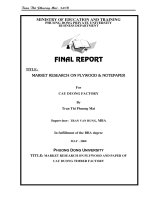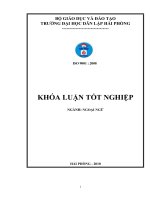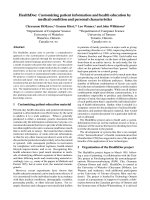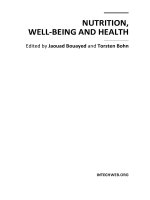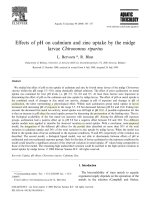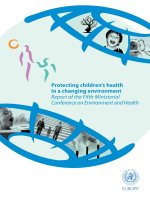European Research on Environment and Health Funded by the Sixth Framework Programme pdf
Bạn đang xem bản rút gọn của tài liệu. Xem và tải ngay bản đầy đủ của tài liệu tại đây (1.28 MB, 50 trang )
General information
EUR 23460 EN
European Research
on Environment and Health
Funded by the Sixth
Framework Programme
Interested in European research?
RTD info is our quarterly magazine keeping you in touch with main developments
(results, programmes, events, etc).
It is available in English, French and German. A free sample copy or free subscription can be
obtained from:
European Commission
Directorate-General for Research
Information and Communication Unit
B-1049 Brussels
Fax: (32-2) 29-58220
/>EUROPEAN COMMISSION
Directorate-General for Research
Directorate I – Environment
Unit I5 – Climate change and environmental risks
E-mail:
Compiled by Dr Tuomo Karjalainen, Scientic Ofcer ()
European Research on Environment and Health
Projects of the Sixth Framework Programme
edited by
Climate Change and Environmental Risks Unit
Environment Directorate
EUR 23460 EN2008 Directorate-General for Research
EUROPEAN COMMISSION
LEGAL NOTICE
Neither the European Commission nor any person acting on behalf of the Commission
is responsible for the use which might be made of the following information.
The views expressed in this publication are the sole responsibility of the author
and do not necessarily reect the views of the European Commission.
A great deal of additional information on the European Union is available on the Internet.
It can be accessed through the Europa server ().
Cataloguing data can be found at the end of this publication.
Luxembourg: Ofce for Ofcial Publications of the European Communities, 2008
ISBN 978-92-79-08853-7
DOI 10.2777/98015
© European Communities, 2008
Reproduction is authorised provided the source is acknowledged.
Printed in Belgium
PRINTED ON WHITE CHLORINE-FREE PAPER
EUROPE DIRECT is a service to help you nd answers
to your questions about the European Union
Freephone number (*):
00 800 6 7 8 9 10 11
(*) Certain mobile telephone operators do not allow access to 00 800 numbers
or these calls may be billed.
2
Foreword
The European Union has been at the forefront of research in the area of environment and health
since the start of the Fifth Framework Programme of Research (FP5 – 1998-2002), which included
an Environment and Health key action
1
. The recent finalisation of over 90 multinational multidis-
ciplinary projects funded by FP5 has greatly expanded our understanding of the complex linkages
between environmental risk factors and their eects on the health of individuals and populations.
This knowledge has been central to the development of national and EU policy initiatives de-
signed to protect the environment and promote human health throughout the community, such
as the European Environment and Health Action Plan, adopted in 2004. Its main aim is to improve
the understanding of the link between environmental factors and health. The implementation of
the goals of this action plan through research started in the Sixth Framework programme (FP6
- 2002-2006) via the funding of many large- and small-scale research projects on health topics
identified as priorities in the Action Plan
2
.
This booklet will bring you a short overview of the FP6 projects, most of which are still ongoing and
which are being funded by four Directorates (Health, Biotechnologies/Agriculture/Food, Industrial
Technologies, and Environment) in the European Commission’s Directorate-General for Research.
This has allowed the concerted eorts and funding of research to tackle a multitude of issues re-
lated to environment and health. First results became available during the course of 2007. We hope
that the reader will find in this overview some answers to important questions raised by the general
public, scientific community or policy-makers on environment-health linkages.
Manuela Soares
Director
European Commission
Research Directorate-General
Environment Directorate
1 />2 Fore more information, go to:
3
4
Table of contents
Foreword 3
The Environment and Health team in 2008 7
Reviews and establishment of state of science of priority E&H issues 8
Human biomonitoring, biobanks, harmonisation 11
Testing of chemicals, in vitro methods 13
Eects and mechanisms of exposure to environmental stressors: allergy/asthma 18
Eects and mechanisms of exposure to environmental stressors: cancer 20
Eects and mechanisms of exposure to environmental stressors:
reproduction, development and ageing 23
Multiple eects and mechanisms of exposure to chemicals 25
Methods for integrated risk assessments of cumulative stressors 27
Health impact assessments and cost/benefit analyses 29
Risk/benefit analyses 32
Emerging environment and health risks: climate change 34
Emerging environment and health risks: waterborne stressors 38
Emerging environment and health risks: nanoparticles 40
5
6
The Environment and Health team in 2008
Research Programme Ofcers
Climate Change and Environmental Risks Unit I-5, Environment Directorate of the European
Commission’s Research Directorate-General, Brussels
Claus Bruening ()•
Tuomo Karjalainen ()•
Tomas Turecki ()•
For news and activities of our Directorate,
see the EU Research for the Environment newsletter
3
and the Directorate website
4
More details on the projects is available in two catalogues downloadable from:
/> />3 />4
7
Reviews and establishment of state
of science of priority E&H issues
CAIR4HEALTH
Clean air for health - research
needs for sustainable develop-
ment policies
EC contribution €0.4M
www.cair4health.eu
Strengthening and exploitation of research results ob-•
tained by European and other projects related to air quality
and health impacts, with reference to the EU Environment &
Health Action Plan.
Identification of the technology development and deploy-•
ment needs in the area of air pollution and health impact
mitigation, for the Environmental Technology Action Plan
and the Thematic Strategy on the Urban Environment.
Support for the European Commission by providing advice •
on its R&D priorities.
Facilitation of the interaction, dissemination and future de-•
velopment of air quality and health research programmes,
clusters, and networks.
Enhancing the global dissemination of air quality and health •
research.
COST281
Potential health implications
from mobile communication
systems
EC contribution €95,000
www.cost281.org
COST281 is part of the COST framework, aimed at European •
cooperation in the field of scientific and technical research.
Better understanding of the possible health impacts of •
emerging technologies, especially related to information
and communication technologies that may result in expo-
sure to electromagnetic fields.
Scientific evaluation of the data available for use by various •
decision-makers involved in the risk management of elec-
tromagnetic fields.
Serving as a basis for risk communication eorts related to •
emerging technologies, electromagnetic fields and possi-
ble health risks.
Collection of data, at the European level, on electromagnetic •
field exposures related to emerging technologies.
8
EMF-NET
Effects of the exposure to
electromagnetic elds: from
science to public health and
safer workplace
EC contribution €1.5M
www.jrc.cec.eu.int/emf-net
ENVIE
Coordination action on indoor
air quality and health effects
EC contribution €0.8M
www.envie-iaq.eu/home.html
Providing a framework for the coordination and collation of •
the results of national and EU-level studies on electromag-
netic fields.
Establishment of expert groups focused on the improve-•
ment of specific aspects common to research in this field.
Supporting “informed decision-making” for regulation and •
risk communication by harmonising results and providing
information to regulatory bodies, industries and consumer
associations.
Providing a framework for coordinating results, their dissem-•
ination, producing an inventory of all ongoing research and
the prompt identification of research priorities and needs.
Increase the understanding of the public health impacts •
arising from indoor air quality across Europe.
A novel approach that starts with the most pronounced in-•
door air health-related outcomes, then determines the main
exposures, causes and sources and thereby outlines the
most relevant policies.
Identify the most widespread and significant indoor causes •
for these health impacts, evaluating the existing and op-
tional building and housing-related policies for controlling
them.
Addressing in particular how indoor air quality might be •
contributing to the rise in asthma and respiratory allergies,
together with other acute and chronic health impacts.
Building on the existing scientific experience rather than •
conducting new research, reviewing the literature and ar-
ticles that have accumulated in domestic and international
indoor air research projects over the past 20 years.
Dissemination of the results through the organisation of an-•
nual conferences and reports.
9
HENVINET
Health and environment
network
EC contribution €3.2M
www.henvinet.eu
PRONET
Pollution reduction options
network
EC contribution €0.8M
www.proneteurope.eu
Establishment of long-term cooperation between research-•
ers, policymakers, and other stakeholders in the field of en-
vironment and health research and assessment.
Establishment of expert teams for each of the four prior-•
ity diseases of the European Environment and Health Action
Plan (allergy/asthma; cancer; neurodevelopmental disor-
ders; endocrine disrupting eects), to summarise the current
scientific basis regarding the links between health and the
environment, including the integration of research by New
Member States.
Ecient dissemination of all resulting materials (policy-rel-•
evant research results and summaries, best practice, deci-
sion support-tool descriptions), by uploading into a dynamic
web-based information system and making them available to
stakeholders outside the project.
Promoting closer linkages with policy-making through en-•
hanced dissemination.
Validation and exploitation of decision support tools, led •
by the joint eorts of environmental experts, experts on the
modelling of environmental eects on physiology and health
experts.
Facilitation of exchange and evaluation of interventions on •
environment and health exposure reduction measures on a
regional level.
Promoting the implementation of successful initiatives in •
other regions of Europe.
Focus on the exchange of useful practices in two areas: the •
improvement of indoor air quality and the reduction of trac-
related health hazards.
Dissemination of results amongst stakeholders across Eu-•
rope, and using the results to make policy recommendations
at the regional level.
P R O N E T
10
Human biomonitoring, biobanks,
harmonisation
ESBIO
Development of a coherent ap-
proach to human biomonitor-
ing in Europe
EC contribution €1.1M
www.eu-humanbiomonitoring.
org/sub/esbio.htm
Development of a coordinated approach for biomonitoring •
based on existing expertise available in Member States sur-
veillance programmes and results from research.
Elaboration of how biomonitoring results can be integrated •
most eciently with environmental monitoring and regis-
tered health data.
Development of strategies to increase transparency and com-•
municate biomonitoring results to stakeholders, including
the establishment of open websites with links to national and
international activities.
Elaboration of scenarios for the use of biomonitoring results •
for policymaking.
PHOEBE
Harmonising population-based
biobanks and cohort studies to
strengthen the foundation of
European biomedical science
in the post-genome era
EC contribution €0.8M
www.populationbiobanks.org
Establishment of a cost-eective and harmonised network of •
population-based biobanks and longitudinal cohort studies
across Europe and Canada, allowing greater collaboration
and avoiding repetition.
Identification and description of large population-based •
biobanks and longitudinal cohort studies in Europe, focusing
on those that can contribute to the investigation of genetic
and environmental determinants of complex diseases.
Identification of new biobank opportunities in Europe, espe-•
cially for genetically isolated populations.
To create an operational infrastructure for the evaluation of on-•
going large-scale genotyping eorts in population cohorts.
To lay the groundwork for a harmonised approach to the as-•
sessment of a wide range of complex phenotypes and life-
style exposures.
To establish ethical-legal and governance criteria that will en-•
able data and sample sharing for research purposes.
11
NORMAN
Network of reference labo-
ratories and related or-
ganisations for monitoring
of emerging environmental
pollutants
EC contribution €1.9M
www.norman-network.com
Establishment of a European network of reference laborato-•
ries, research centres and related organisations (including
standardisation bodies) in order to:
improve the exchange of information on emerging envi- –
ronmental contaminants;
encourage the validation and harmonisation of common –
measurement methods and monitoring tools so that the
demands of risk assessors and risk managers can be
better met.
NORMAN will develop into a source of information on emerg-•
ing environmental substances, keeping stakeholders and
the public informed about the state of monitoring, risk as-
sessment, and management of emerging substances, and
that through databases, newsletters, workshops and con-
tact points.
12
Testing of chemicals, in vitro methods
A-CUTE-TOX
Optimization and pre-valida-
tion of an in vitro test strategy
for predicting human acute
toxicity
EC contribution €9.0M
www.acutetox.org
Development of an in vitro test strategy to replace in vivo test-•
ing (animal testing) of the acute toxicity of chemicals.
Anticipated corollary results of this overall objective are decreased •
testing costs and improved scientific validity of the results.
Generation of in vivo and in vitro databases: results of previ-•
ous studies will be compiled into comprehensive databases
of in vivo and in vitro acute toxicity data.
Selection and refinement of in vitro tests: a wide range of in •
vitro test types will be evaluated and the most promising and
accurate ones will be further refined.
Development of an in vitro test strategy: integrate the knowl-•
edge amassed into an expert system capable of providing a
reliable value for a chemical’s acute in vivo toxicity.
Implementation of in vitro test strategy: the in vitro test strat-•
egy developed should gain regulatory approval and become
widely implemented in industry.
CAESAR
Computer assisted evaluation of
industrial chemical substances
according to regulations
EC contribution €1.5M
www.caesar-project.eu
Production of models to be used for regulatory purposes, •
(such as the implementation of the REACH proposal) for the
prediction of the toxicity of chemical substances in a trans-
parent manner, by applying new and unique modelling and
validation methods.
Reduction of animal testing and its associated costs.•
Achievement of a wide applicability and acceptability of mod-•
els by a network of stakeholders to address the targets of the
(Q)SAR models and the features for model use.
Promotion and exploitation of CAESAR activities.•
13
Development of in vitro methods for testing the carcinogenic •
properties of compounds as an alternative to current rodent bio-
assays for assessing chemical genotoxicity and carcinogenicity.
The major goal is to develop a battery of mechanism-based in •
vitro tests representative for various modes of carcinogenic
action in the lungs, liver and kidney, reducing costs and ani-
mal testing and speeding up the identification of substances
potentially harmful to man.
The application of “omics” technologies to robust in vitro sys-•
tems, exploring stem cell technology to generate responses
from a set of model compounds causing genotoxicity and
carcinogenicity.
EXERA
Development of 3D in vitro
models of estrogen-reporter
mouse tissues for the phar-
maco-toxicological analysis
of nuclear receptors-interact-
ing compounds (NR-ICs)
EC contribution €2.2M
www.altaweb.it/exera/
Development of novel 3D in vitro models of mouse tissues •
from five major organs for the pharmaco-toxicological analy-
sis of oestrogen receptor-interacting compounds: liver, skin
and bone (non reproductive systems), ovary and testis (male
and female reproductive systems).
Integration of innovative technologies such as the 3D cul-•
tures, established transgenic mouse lines and genomic plat-
forms for characterisation of ER-ICs.
CARCINOGENOMICS
Development of a high
throughput genomics-based
test for assessing genotoxic
and carcinogenic properties of
chemical compounds in vitro
EC contribution €10.4M
www.carcinogenomics.eu
NHR DevTox
A prospective analysis of
the mechanisms of nuclear
hormone receptors and their
potential as tools for the as-
sessment of developmental
toxicity
EC contribution €0.1M
website not available
Production of a prospective analysis of the mechanisms of •
nuclear hormone receptors and their potential as tools for
the assessment of developmental toxicity.
Investigation of the role of nuclear hormone receptors in de-•
velopmental and reproductive biology and review the state of
science in the field.
Definition of a practical research programme about develop-•
mental toxicity and the role of nuclear receptors.
Development of a plan to for the future assessment of the rel-•
evance of in vitro systems as predictive models for develop-
ment toxicity.
14
Development of integrated testing strategies (ITS) for the •
REACH regulatory framework, allowing for the increase of non-
testing information for decision making and reducing animal
testing. This will include the development of operational pro-
cedures for the evaluation of chemical substances in a risk-
driven, context-specific and substance-tailored manner.
Elaboration of methods and guidance for transparent and sci-•
entifically sound use of chemistry-driven information in ITS.
Ecient strategies and guidance for the exploitation of all types •
of biological information on toxic eects of chemicals in ITS,
focusing on reduced animal use and informed extrapolation.
Development of criteria for exposure-informed testing as •
foreseen in REACH and refinement of relevant exposure as-
sessment methods accordingly.
OSIRIS
Optimized strategies for risk
assessment of industrial
chemicals through integra-
tion of non-test and test
information
EC contribution €10.0M
www.osiris.ufz.de
PREDICTOMICS
Short-term in vitro assays for
long-term toxicity
EC contribution €2.3M
www.predictomics. com
Improving the understanding of the mechanisms of chron-•
ic toxicity to identify relevant early changes induced by
chronic toxins.
Development of advanced and innovative liver and kidney •
cell culture models, including cell transformation and stem
cell technology.
Increasing the sensitivity and accuracy of genomic, proteom-•
ic, and cytomic tools for toxicity studies, including the identi-
fication of primary and secondary biomarkers.
Establishment of a hierarchical decision tree, based on the •
identified primary and secondary biomarkers, as well math-
ematical models to early anticipate the potential toxicity risk
of drugs under development.
Prevalidation of the screening platform. •
15
Organisation of a workshop to which were invited commu-•
nities with experience in animal and non-animal data and
predictions from computer-based modelling to discuss how
to achieve a better risk assessment of chemical compounds,
integrating their experiences through the workshop.
The discussion focused on how to integrate and make opti-•
mal use of the dierent kinds of data.
The overall objective of the workshop was integration be-•
tween the multidisciplinary and multisectoral competencies.
REPROTECT
Development of a novel ap-
proach in hazard and risk
assessment or reproductive
toxicity by a combination and
application of in vitro, tissue
and sensor technologies
EC contribution €9.1M
www.reprotect.eu
Provision of an array of in vitro tests for the investigation of •
the dierent aspects and phases of the reproductive cycle,
aiming to contribute to the development of intelligent test-
ing strategies for the compilation of reliable and valid safety
information.
Bringing about, by this new testing strategy for reproduc-•
tive toxicology, a decrease in the number of animal tests
and providing more detailed information on mechanisms of
toxicity in the dierent target tissues.
Making it possible to screen for reproductive toxicity during •
the lead selection phase in the drug development process
and providing a refined hazard identification of chemicals.
Dissemination activities, with a view to informing the regula-•
tory process in particular.
RAINBOW
Research on animal and in
vitro studies and numerical
methods: bridging opportuni-
ties through a workshop
EC contribution €0.2M
www.rainbow-project.eu
RETHINK
Minipigs as models for the
toxicity testing of new medi-
cines and chemicals: impact
assessment
EC contribution €0.2M
www.rethink-eu.dk
Evaluation of the potential impact of toxicity testing in the •
mini-pig as an alternative approach in regulatory toxicity
testing that can contribute to the replacement, refinement
and reduction of animal testing (3Rs).
The issues to be covered in this impact assessment include •
animal welfare and ethical issues, the development of new
medicines and chemicals, safety testing issues and genom-
ics and emerging technologies issues.
16
Development of strategies to replace animal testing with in •
vitro alternative assays for identifying skin and respiratory
sensitizers in relation with the use of safe ingredients by the
chemical, cosmetic and pharmaceutical industries.
Creation of in vitro tests and test strategies allowing for the •
testing of sensitising potency of new and existing chemical
entities produced by European industries, for classification,
labelling and risk assessment.
Coordinated and extensive characterisation of the impact of •
compounds on cell-cell interactions for identification of the
key mechanisms of sensitisation.
Development of assay systems that model sensitisation rath-•
er than irritation and toxicity.
SENS-IT-IV
Novel testing strategies for in
vitro assessment of allergens
EC contribution €11.0M
www.sens-it-iv.eu
TESTMETEDECO
Development of test methods
for the detection and charac-
terisation of endocrine-dis-
rupting chemicals in environ-
mental species
EC contribution €0.2M
website not available
Development of test methods for the detection and charac-•
terisation of endocrine disrupting chemicals in environmen-
tal species.
Participating in a pan-OECD eort to synthesise research ef-•
forts in the EU, the USA and Japan with a view to creating new
methods for screening and testing the hazard assessment of
chemicals in environmental species.
The EU contribution is specifically in the validation work – the •
statistical report writing, and coordinating aspects.
17
Effects and mechanisms of exposure to
environmental stressors: allergy/asthma
EUROPREVALL
The prevalence, cost and basis
of food allergy across Europe
EC contribution €14.1M
www.europrevall.org
Delivering an improved quality of life to food allergy suer-•
ers by developing knowledge-based holistic approaches to
managing the problem.
Establishing the prevalence of food allergies in adults and •
children, and the patterns of reactivity to the five main al-
lergic foods across Europe.
Identifying new and emerging food allergies in Eastrn Europe •
and the Far East.
Investigating the relationship between genetic and environ-•
mental factors
Providing a library of highly characterised, authentic food •
allergens, and information about the eect of the food ma-
trix and food processing in modulating the allergenic prop-
erties of foods.
Developing novel diagnostic and predictive tools and methods.•
Ascertaining the socioeconomic impact and cost of food •
allergies,and their treatments, to the European Community.
18
GABRIEL
A multidisciplinary study to
identify the genetic and envi-
ronmental causes of asthma in
the European Community
EC contribution €11.0M
www.gabriel-fp6.org
Post-genomic approach to understanding the molecular ba-•
sis of asthma, aiming at preventive and therapeutic control.
Integrated multidisciplinary programme that brings togeth-•
er specialists in epidemiology, genetics, genomics, pro-
teomics, bioinformatics, statistics, environmental ecology
and immunology to focus on the causes of asthma.
Identification of how gene-environment interactions cause •
the development of asthma, translating the findings into
cellular and genomic models to identify the molecular
mechanisms.
Study of rural farming environments, which are more protec-•
tive against asthma, in order to develop novel therapeutics.
Integration of the results into the European knowledge base •
for patient understanding and disease prevention.
GA2LEN
Global allergy and asthma
European network
EC contribution €14.4M
www.ga2len.com
Establishment of a European network of excellence, bring-•
ing together 31 partners and over 50 collaborating centres.
The teams have excellent track records conducting specific
integrated multidisciplinary research programmes on is-
sues relating to the environment (including outdoor and in-
door pollution), nutrition, lifestyle (including occupation),
infections and genetic susceptibility.
Study of allergy and asthma throughout the course of life, •
including intrauterine life and the foeto-maternal interface.
Study of interactions between genetic and environmental •
factors in early life and the development of allergies, via ex-
isting and new birth cohorts.
Investigation of the gene-environment interactions, via ge-•
netic and epidemiological studies, that might have under-
pinned the dramatic increase in allergy rates in the EU.
Through region-specific epidemiological studies, investigation •
of the impact of nutritional status on allergic disposition.
Dissemination of information to patients and the public. •
19
Effects and mechanisms of exposure
to environmental stressors: cancer
DIEPHY
Dietary exposures to polycyclic
aromatic hydrocarbons and
DNA damage
EC contribution €1.5M
www.imp.lodz.pl/diephy/
home.htm
Providing an adequate base for interpretation of human •
cancer data using novel approaches towards the induction
and repair of DNA lesions from polycyclic aromatic hydro-
carbons (PAH), as well as studying the interaction between
DNA adducts and oxidative stress.
Tracing the origin of high levels of background DNA adducts •
of the PAH type found in certain non-smoking individuals,
taking diet and genetic factors into account.
Assessing protective eects against neoplastic disease of •
selected dietary constituents.
Developing sensitive techniques for determining certain •
types of DNA damage, including cytogenetic eects.
Gaining new insights into the formation and repair of DNA-•
adducts generated from PAHs, as well as their relation to
oxidative damages and aptosis.
Investigating the level of DNA adducts in dierent human •
cohorts in Poland, Serbia, and Italy.
ECNIS
Environmental cancer risk,
nutrition and individual
susceptibility
EC contribution €11.0M
www.ecnis.org
Network of Excellence devoted to integrating European en-•
vironmental carcinogenesis research in order to reduce the
cancer burden. This includes integration, joint research and
spreading of excellence activities.
Development of biomarkers for carcinogens through mo-•
lecular epidemiology studies.
Investigation of how nutrition and genetic disposition aect •
susceptibility to cancer.
Development of hazard and risk assessment strategies, and •
the evaluation of ethical issues arising from the use of bi-
omarkers in cancer research.
Better understanding of cancer etiology for more eective •
cancer prevention.
20
EUROLYMPH
Collaborative European action
into environmental, nutritional
and genetic factors in non-
Hodgkin’s lymphoma aetiology
EC contribution €0.4M
website not available
NEWGENERIS
Newborns and genotoxic expo-
sure risks: Development and
application of biomarkers of
dietary exposure to genotoxic
and immunotoxic chemicals
and of biomarkers of early ef-
fects, using mother-child birth
cohorts and biobanks
EC contribution €13.6M
www.newgeneris.org
Development of a network of studies to investigate the •
association between environmental risk factors and non-
Hodgkin’s lymphoma (NHL).
Detailed investigation of environmental and nutritional risk •
factors previously suggested to be associated with NHL,
based on the pooled data from the studies participating in
the InterLymph consortium ( />InterLymph).
Production of results on risk of NHL for exposure to dier-•
ent categories of pesticides and solvents, organic dusts,
ultraviolet radiation, and contact with animals and animal
related products, and on their interplay with genetic sus-
ceptibility factors.
Testing the hypothesis that maternal exposure to dietary •
compounds with carcinogenic and immunotoxic properties
results in in utero exposure and molecular events in the
embryo, leading to increased risks of cancer and immune
disorders in childhood.
Development of biomarkers of exposure, carcinogenic and •
immunotoxic risks and of susceptibility and application
using high throughput techniques, and setting up new
biobanks.
Assessment of dietary exposure of pregnant women to di-•
etary carcinogens and immunotoxins.
Application of epidemiological surveys of mother/child birth •
cohorts to study associations between maternal dietary ex-
posure and childhood cancer and immune disorders risks.
Inform policy makers in the improvement of health policy, food •
safety and food quality, contributing to better child health.
Improving the scientific basis for the development of health-•
promoting foods.
Contributing to policy development through the evaluation •
of human carcinogens.
21
FURAN-RA
Role of genetic and non-ge-
netic mechanisms in furan risk
EC contribution €1.5M
www.furan-ra.toxi.uni-wuerz-
burg.de
Risk benefit analysis of health risks in humans as a result of •
dietary exposure to furan (present in many foods, especially
processed).
Characterization and quantitation of DNA- and protein •
binding of furan in liver of rats and mice over a wide dose
range. This includes the assessment of the genotoxic and
clastogenic potential of furan in rodent liver by comet assay,
cytogenetics, and biomarkers of genetic damage.
Analysis of furan in food, and mechanisms of formation dur-•
ing food processing, as a better basis for exposure assess-
ment from food and mechanisms of formation during food
processing.
Provision of a risk assessment of furan in food.•
22
Effects and mechanisms of exposure to
environmental stressors: reproduction,
development and ageing
CRESCENDO
Consortium for research into
nuclear receptors in develop-
ment and aging
EC contribution €10.0M
www.crescendoip.org
Main objective is to exploit new advances in (post-)genom-•
ics and bioinformatics and associated technological de-
velopments. This will enhance understanding of the basic
mechanisms underlying nuclear hormone receptor super-
family (NR) actions, and their translation into the physiolog-
ical regulation of developmental and aging processes.
Improvement of understanding of NR signalling in the con-•
text of regulatory networks.
Investigation of the roles of NRs in the continuum of devel-•
opment to aging, with emphasis on complex links between
NR signalling, metabolic disease, as well as brain develop-
ment and aging.
Increase in knowledge of how NR-related information in the •
genome impacts on phenotype.
Transfer of this knowledge into therapeutic leads. •
DEVNERTOX
Toxic threats to the developing
nervous system: in vivo and in
vitro studies on the effects of
mixture of neurotoxic sub-
stances potentially contami-
nating food
EC contribution €2.4M
www.imm.ki.se/devnertox
Development of standardised testing protocols based on •
the use of multiple in vitro experimental models.
Identification of specific biochemical, molecular and func-•
tional endpoints, based on the mechanism of action of
Methylmercury (MeHg) and polychlorinated biphenyls
(PCBs), both alone and in combination.
Evaluation of the neurotoxic eects of MeHg and PCBs dur-•
ing development, including the long-term consequences
and gender-related aspects.
Definition of quantitative measures of observed eects •
(benchmark doses, EC50, etc.) for risk-assessment purpos-
es, and incorporation of currently available human and ani-
mal data to derive guidelines for exposure limits.
23
